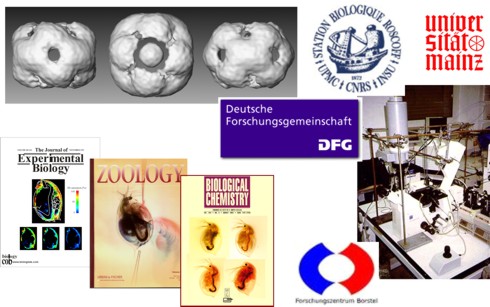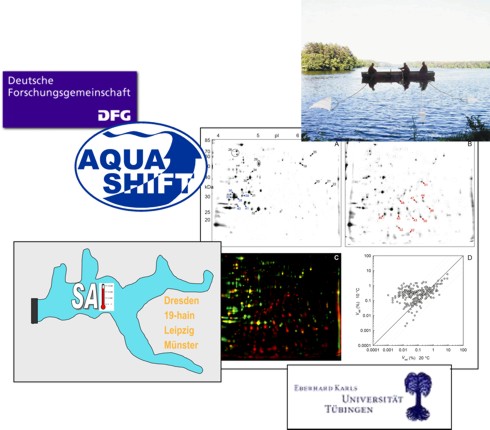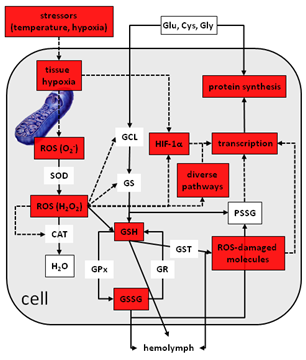1. Oxygen transport in Daphnia at variable oxygen conditions

- Optophysiological analyses of the oxygen transport cascade in Daphnia
- Structure and function of Daphnia hemoglobins (Hb): Hb genes & synthesis sites, Hb induction (transcription factors, Hb mRNA & subunits), subunit composition, heterogeneity and quarternary structure of Hb macromolecules
- Adjustments to variable oxygen conditions on the behavioural level (oxygen preference)
- Adjustments to variable oxygen conditions on the biochemical level (proteome, protein structure and function, metabolites)
Selected references:
Paul, Zeis, Lamkemeyer, Seidl, Pirow (2004) Control of oxygen transport in the microcrustacean Daphnia: regulation of haemoglobin expression as central mechanism of adaptation to different oxygen and temperature condtions. Acta Physiol Scand 182: 259-275
Lamkemeyer, Paul, Stöcker, Yiallouros, Zeis (2005) Macromolecular isoforms of Daphnia magna haemoglobin. Biol Chem 386: 1087-1096
Lamkemeyer, Zeis, Decker, Jaenicke, Waschbüsch, Gebauer, Markl, Meissner, Rousselot, Zal, Paul (2006) Molecular mass of macromolecules and subunits and quarternary structure of haemoglobin from the microcrustacean Daphnia magna. FEBS J 273: 3393-3410
Zeis, Lamkemeyer, Paul, Nunes, Schwerin, Koch, Schütz, Madlung, Fladrer, Pirow (2009) Acclimatory responses of the Daphnia pulex proteome to environmental changes. I. Chronic exposure to hypoxia affects the oxygen transport system and carbohydrate metabolism. BMC Physiol 9: 7
Weber, Pirow (2009) Physiological responses of Daphnia pulex to acid stress. BMC Physiol 9 :9
Schwerin, Zeis, Horn W, Horn H, and Paul (2010) Hemoglobin concentration in Daphnia (D. galeata-hyalina) from the epilimnion is related to the state of nutrition and the degree of protein homeostasis. Limnol Oceanogr 55: 639–652
Gerke P, Börding C, Zeis B, Paul RJ (2011) Adaptive haemoglobin gene control in Daphnia pulex at different oxygen and temperature conditions. Comp Biochem Physiol A 159:56-65
Zeis B, Becker D, Gerke P, Koch M, Paul RJ (2013) Hypoxia-inducible haemoglobins of Daphnia pulex and their role in the response to acute and chronic temperature increase. BBA Proteomics 1834:1704-1710
Cuenca Cambronero M, Zeis B, Orsini L (2017) Haemoglobin-mediated response to hyper-thermal stress in the keystone species Daphnia magna. Evol Appl 11:112-120



